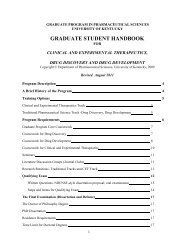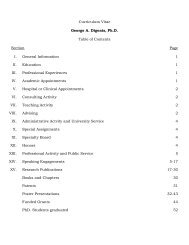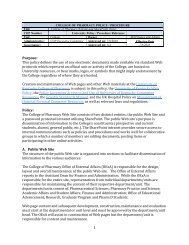Winter 2007 [pdf] - University of Kentucky - College of Pharmacy
Winter 2007 [pdf] - University of Kentucky - College of Pharmacy
Winter 2007 [pdf] - University of Kentucky - College of Pharmacy
You also want an ePaper? Increase the reach of your titles
YUMPU automatically turns print PDFs into web optimized ePapers that Google loves.
New Rese<br />
Volunteer Faculty Guide t<br />
Mac Bray <strong>of</strong> Frankfort graduated from<br />
the UK <strong>College</strong> <strong>of</strong> <strong>Pharmacy</strong> 30 years ago,<br />
but he says he hasn’t stopped learning about<br />
the pharmacy pr<strong>of</strong>ession. Not only does he<br />
share his wisdom with current UK <strong>College</strong><br />
<strong>of</strong> <strong>Pharmacy</strong> students, sometimes they are the<br />
source <strong>of</strong> his new knowledge.<br />
Bray is among the more than 300 communitybased<br />
volunteer faculty members who serve as<br />
preceptors and mentors to fourth-year pharmacy<br />
students required to complete 10 one-month clinical<br />
rotations as part <strong>of</strong> their Advanced <strong>Pharmacy</strong> Practice<br />
Experience prior to graduation.<br />
“Just as is the case with all pharmacy schools<br />
across the country, we depend on volunteer faculty<br />
to provide experience to our students and prepare<br />
them for their future in this pr<strong>of</strong>ession,” said John<br />
Piecoro, Pharm.D., director <strong>of</strong> experiential education<br />
at the UK <strong>College</strong> <strong>of</strong> <strong>Pharmacy</strong>. “Pharmacists who<br />
volunteer as community-based faculty are some <strong>of</strong><br />
the most progressive practitioners and our students<br />
<strong>of</strong>ten have the opportunity to assist in expanding their<br />
services such as helping in immunization programs<br />
or health screenings.”<br />
This year, 95 fourth-year students will complete a<br />
total <strong>of</strong> 950 rotations. Sites available are located in every<br />
corner <strong>of</strong> the state and everywhere in between. Preceptors<br />
represent nearly every facet <strong>of</strong> the pharmacy pr<strong>of</strong>ession.<br />
About 75 percent are UK alumni with the remainder<br />
graduates <strong>of</strong> other pharmacy schools now practicing in<br />
the Commonwealth, said Mike Richardson, program<br />
coordinator for the experiential program.<br />
“Many students say their fourth year <strong>of</strong> pharmacy<br />
school is the most rewarding because they’re getting<br />
to practice the knowledge they have accumulated over<br />
the past three years,” Richardson said. Although they<br />
benefit from the services <strong>of</strong> the students, preceptors are<br />
committed to working and supervising the students<br />
including spending one-on-one time with them, he<br />
Fourth-year pharmacy student Jessica Tackett <strong>of</strong> Georgetown works with Frankfort pharmacist and volunteer communitybased<br />
faculty member Mac Bray at Capital <strong>Pharmacy</strong> during her December clinical rotation.<br />
said. “We’re fortunate to have so many alumni and<br />
other practitioners in <strong>Kentucky</strong> devoted to seeing the<br />
next generation <strong>of</strong> pharmacists succeed.”<br />
Bray, a 1976 graduate, and owner <strong>of</strong> Capital<br />
<strong>Pharmacy</strong>, mentors about seven to 10 pharmacy<br />
students a year providing them with some <strong>of</strong><br />
the unique experiences found in operating an<br />
independent pharmacy. “Along with medication<br />
therapy management (MTM), health screenings, flu<br />
and shingles vaccines, students are exposed to the<br />
business side <strong>of</strong> running an independent pharmacy<br />
including third-party billing and other financial<br />
considerations,” he said. The “back room work” <strong>of</strong><br />
third-party billing is different than they will find in<br />
other pharmacies, he said.<br />
Jessica Tackett, a fourth-year student from<br />
Georgetown, was working with Bray during<br />
December. She says so far during her rotations<br />
she’s had the opportunity to practice many aspects<br />
<strong>of</strong> her clinical pharmacy education such as giving<br />
immunizations and compounding medications as well<br />
as learn more about the entrepreneurial and business<br />
management elements <strong>of</strong> the pr<strong>of</strong>ession.<br />
Bray says Tackett, like all the UK students who<br />
come to work in his Frankfort business, are well<br />
prepared to handle the increasing demands <strong>of</strong> the<br />
pharmacy pr<strong>of</strong>ession.<br />
“I do my best in teaching them about the business,<br />
but I find I’m always learning from them too.”<br />
6<br />
MINORITY Continued from Page 1<br />
But reaching out to undergraduate students isn’t always the best way to recruit future<br />
pharmacy students, said Vickie Henderson, director <strong>of</strong> recruitment for the UK <strong>College</strong><br />
<strong>of</strong> <strong>Pharmacy</strong>.<br />
“We’ve learned you can’t wait until students get to college to begin recruiting,” she said.<br />
“It is important to engage younger students and educate them as early as in middle school<br />
on what pharmacy is and the career opportunities that exist. Students also have to know<br />
what they need to do in high school – such as take advanced science and math courses every<br />
year – to get them ready for the college curriculum that eventually will prepare them for<br />
pharmacy school admission.”<br />
In addition to recruiting a diverse student body, retaining minority students is imperative,<br />
Lubawy said. “We hope the activities being <strong>of</strong>fered once students are enrolled in our program<br />
will be a significant factor in providing an inviting multicultural environment.”<br />
AKERS, WENDELL SCOTT, $21,000, American Heart Association<br />
Ohio Valley Affiliate, Julie Oestreich Fellowship: The Effects <strong>of</strong> P2Y12<br />
Polymorphism on Platelet Receptor Density and Activation.<br />
ANDERSON, BRADLEY D., $150,000, Arno Therapeutics Inc., Kinetic<br />
Control to Optimize Antitumor Efficacy <strong>of</strong> Liposomal Camptothecin<br />
Prodrugs.<br />
STINCHCOMB, AUDRA L., $14,650, AllTranz, Evaluation <strong>of</strong><br />
Nanoparticle Drug Delivery.<br />
CROOKS, PETER A., continued, US Worldmeds LLC, KSTC R & D<br />
Voucher: Product development and formulation.<br />
CROOKS, PETER A., continued, Washington <strong>University</strong>,<br />
Radiosensitization by the Cellular Heat Shock Response.<br />
CROOKS, PETER A., continued, <strong>University</strong> <strong>of</strong> Louisville, KSTC: Bone-<br />
Targeting and Bone Anabolic Compounds.<br />
CROOKS, PETER A., continued, Vanderbilt <strong>University</strong>, Pharmacokinetics<br />
<strong>of</strong> Novel Radiation Sensitizers.<br />
CROOKS, PETER A., $25,250, Pradama Inc., Novel Bone-Targeting<br />
Agents.<br />
DELUCA, PATRICK, continued, Swedish Match North America Inc.,<br />
Development <strong>of</strong> a Microencapsulated System for Food Flavors.<br />
DWOSKIN, LINDA P., continued, National Institute on Drug Abuse,<br />
Nicotinic Receptor Regulation <strong>of</strong> Dopamine Transporter.<br />
DWOSKIN, LINDA P., continued, National Institute on Drug Abuse,<br />
Development <strong>of</strong> Novel Treatments for Nicotine Addiction.


![Winter 2007 [pdf] - University of Kentucky - College of Pharmacy](https://img.yumpu.com/27653085/6/500x640/winter-2007-pdf-university-of-kentucky-college-of-pharmacy.jpg)
![Summer 2011 [pdf] - University of Kentucky - College of Pharmacy](https://img.yumpu.com/27653115/1/190x245/summer-2011-pdf-university-of-kentucky-college-of-pharmacy.jpg?quality=85)

![Summer 2007 [pdf] - University of Kentucky - College of Pharmacy](https://img.yumpu.com/27653109/1/190x245/summer-2007-pdf-university-of-kentucky-college-of-pharmacy.jpg?quality=85)
![Summer 2007 [pdf] - University of Kentucky - College of Pharmacy](https://img.yumpu.com/27653114/1/167x260/summer-2007-pdf-university-of-kentucky-college-of-pharmacy.jpg?quality=85)
![Winter 2011 [pdf] - University of Kentucky - College of Pharmacy](https://img.yumpu.com/27653110/1/190x245/winter-2011-pdf-university-of-kentucky-college-of-pharmacy.jpg?quality=85)
![PS Application Form [pdf] - University of Kentucky - College of ...](https://img.yumpu.com/27653102/1/190x245/ps-application-form-pdf-university-of-kentucky-college-of-.jpg?quality=85)

![Curriculum Vitae [pdf] - University of Kentucky - College of Pharmacy](https://img.yumpu.com/27653090/1/190x245/curriculum-vitae-pdf-university-of-kentucky-college-of-pharmacy.jpg?quality=85)

![Winter 2009 [pdf] - University of Kentucky - College of Pharmacy](https://img.yumpu.com/27653072/1/190x245/winter-2009-pdf-university-of-kentucky-college-of-pharmacy.jpg?quality=85)



![Summer 2008 [pdf] - University of Kentucky - College of Pharmacy](https://img.yumpu.com/24193256/1/190x245/summer-2008-pdf-university-of-kentucky-college-of-pharmacy.jpg?quality=85)